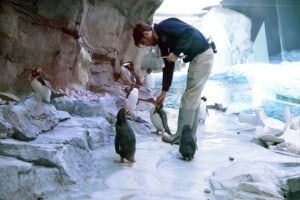 With a price tag of $30 million, Detroit Zoo’s new penguin facility is the largest in the world. Featuring a 325,000-gallon 25-foot-deep aquatic area, and two acrylic underwater tunnels, visitor can watch penguins as they dive, swim and navigate through the technological marvel that is now home to 82 birds.
With a price tag of $30 million, Detroit Zoo’s new penguin facility is the largest in the world. Featuring a 325,000-gallon 25-foot-deep aquatic area, and two acrylic underwater tunnels, visitor can watch penguins as they dive, swim and navigate through the technological marvel that is now home to 82 birds.
When the zoo expressed their need for penguin exam tables, Mopec stepped in and worked with habitat designers to customize, build and donate two “penguin specific” tables.
We met up with Detroit Zoo Bird Department Zookeeper Charlie Ramsey to learn more about the impressive exhibit and birds he cares for.
How long have you been a keeper at the Detroit Zoo and what are the most rewarding aspects of your job?
I have been a bird department zookeeper at the Detroit Zoo for seven years. Some of the most rewarding aspects of my job are knowing that the labor-intensive, often very dirty work that my co-workers and I do every day of the year allows for the penguins in our care to thrive. Another very rewarding aspect of my job is being able to participate in numerous conservation programs throughout the state, including the captive-rearing of endangered Great Lakes piping plovers and the banding and monitoring of wild osprey and black terns.
Can you tell the penguins apart? How many are there?
Eighty-two penguins currently reside at the Polk Penguin Conservation Center. The four species living at the Detroit Zoo are macaroni, rockhopper, gentoo and king penguins. The crested penguins (macaronis and rockhoppers) are easily discernible by their unique, individual personalities. The king penguins can be a little bit trickier as they have more of a flock mentality than the others and tend to keep a bit of distance from the keepers. The gentoos are relatively new arrivals at the Detroit Zoo, making their home here at the end of 2015, so we are still getting to know their personalities. All of our penguins wear colored bands around their wings to help us distinguish them from one another.

How will the Mopec exam tables be used?
The Mopec tables make a great addition to our two management rooms within the Polk Penguin Conservation Center. They will allow for us zookeepers, along with our veterinary staff, to provide medical treatments and physical examinations for the penguins without having to transport them to our onsite animal hospital.
What are the key elements for keeping Detroit Zoo’s penguins healthy and active?
There are several key elements a habitat must have in order for penguins to not only survive, but thrive in captivity. These elements were at the forefront of the design process within the new Polk Penguin Conservation Center. First and foremost, the species living at the Detroit Zoo need a cold environment. The air temperature is kept at about 37 degrees while the water is a brisk 40 degrees. There are a variety of substrates for the penguins to walk on including cobble, small stones, and even fresh snow from our overhead snow machines. These diverse substrates help to maintain healthy feet. Our 25-foot-deep aquatic area allows for the birds to dive deeper than in their previous habitat and has an artificial kelp forest complete with model anemones and sea stars. All of these features provide countless way in which the penguins can interact with their environment and maintain a healthy and active lifestyle.
What are the biggest challenges of keeping the Penguin Conservation Center operational?
The biggest challenges for keeping the penguin center operational are mostly mechanical in nature. Such a large habitat needs an equally large air conditioning system and our in-house expert HVAC technicians do a great job maintaining this system. The water quality must also be sustained to keep our birds healthy, so we employ the use of a very large, very complicated water filtration system, which our aquatic life-support technicians maintain.
What is the Detroit Zoo’s role in penguin conservation?
The Detroit Zoological Society fulfills multiple roles when it comes to penguin conservation. First and foremost being caring for the population of penguins living at the Detroit Zoo. We provide the public with a chance to observe penguins up close, displaying so many natural and highly entertaining behaviors and allowing them to connect on a profound level with these charismatic animals. This level of connection with another species from the opposite side of the planet is so important for conservation efforts. Without it, most people would have no idea how rich the lives of these animals are and how crucial it is to preserve the icy wilderness and oceans in which they naturally live their lives, and which are now more threatened than ever.
The Detroit Zoological Society is involved in penguin conservation programs on three continents. Our most significant project is providing funding for the Polar Oceans Research Group, led by Bill Fraser, who also consulted in the design of the Polk Penguin Conservation Center. One of my fellow zookeepers, Matthew Porter, spent four months this year living and working at the U.S. Palmer Station in Antarctica for a rare and extraordinary scientific opportunity to assist a Polar Oceans Research Group field team with penguin research. The DZS also supports the efforts of the Southern African Foundation for the Conservation of Coastal Birds and Falklands Conservation in South America. The penguin center provides a forum to engage Zoo visitors in these programs, to educate them on the threats that penguins face across the southern hemisphere, and to even meet some of the scientists working with penguins in the wild.
